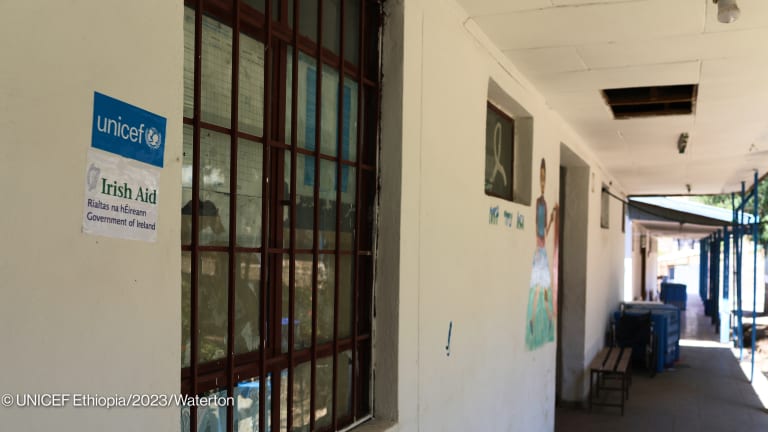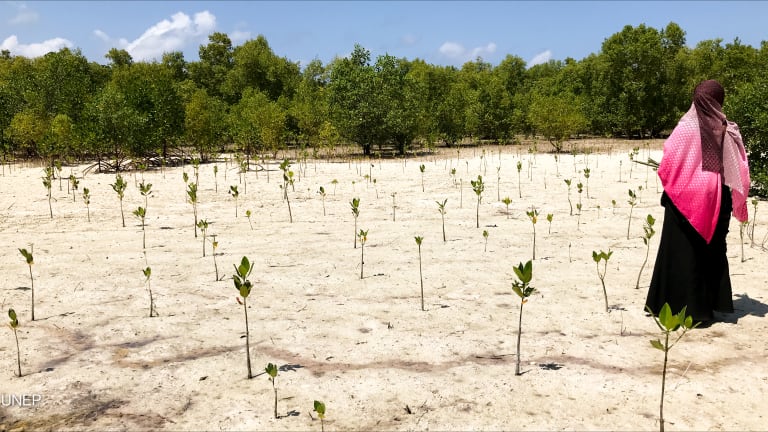Is China headed toward becoming the next aid superpower?
AidData’s latest report shows that $253.1 billion of Chinese funding was spent or committed in other countries between 2018 and 2021.
The historic United States pivot from its lead role in international cooperation, coupled with the wider trend of aid deprioritization among the other major donors, has reopened a conversation around China’s evolving position in the global development sphere. Many are wondering: Could the world’s second-largest economy step up and fill the void left by the U.S.? China has been an active development player since the establishment of its government in 1949. For many years, its focus was on technical assistance and the so-called south-south cooperation, a technical partnership among low- and middle-income countries in the global south. In 2013, it took a major turn with the announcement of the Belt and Road Initiative — a transcontinental strategy aimed at improving connectivity between Asia, Africa, and Europe, primarily through infrastructure projects. Our findings show that while China is not headed in that direction yet, its current aid spending shows a massive potential that warrants a closer look. AidData, a research institute that provides a comprehensive mapping of China’s international financial activities, offers data on 20,985 projects — mostly in low- and middle-income countries — in the 21 years between 2000 and 2021, with a total value of $1.34 trillion. That includes projects that are in the pipeline, ongoing, and completed. It also includes both grants and loans. Not all of this was spent on development activities, but a substantial portion was. In a previous analysis of AidData’s figures, we looked at aid spending in the period from 2000 to 2017. We now looked into the latest additions, which cover the years 2018 to 2021. All figures are in 2021 constant prices. How much money does China give? AidData’s latest report shows that $253.1 billion of Chinese funding was spent or committed in other countries between 2018 and 2021. About 10.8% of that amount, worth $27.2 billion, is similar to what the Organisation for Economic Co-operation and Development, or OECD, counts as official development assistance. China’s ODA-like funding peaked in 2018, at $12.1 billion. After that, China’s ODA-like spending dipped for the rest of the four-year period. It went down by almost 39% between 2018 and 2019 — from $12.1 billion to $7.4 billion. The trend continued the following year, with $3.8 billion, then went up slightly to $4 billion in 2021. The largest chunk of China’s financial activities between 2018 and 2021, worth $204.8 billion, can be counted as other official flows, or OOF, which are transactions that do not fall under ODA criteria. The remaining $21.1 billion went to other forms of financing that cannot be classified. Where is the money going? Sub-Saharan Africa was China’s priority region, receiving $13 billion — 47.9% of the total ODA-like spending — between 2018 and 2021. East Asia and the Pacific ranked next, with almost $4 billion. South Asia followed, with $3.09 billion; Europe and Central Asia, with $3.07 billion; the Middle East and North Africa, with $2.1 billion; and Latin America and the Caribbean, with $1.7 billion. The remaining $166.9 million went to regional projects. <div class='tableauPlaceholder' id='viz1763960957022' style='position: relative'><noscript><a href='#'><img alt='Geographic breakdown of China's foreign activities ' src='https://public.tableau.com/static/images/Ge/GeographicalbreakdownofChinasforeignactivities2018-2021/GeographicbreakdownofChinasforeignactivities/1_rss.png' style='border: none' /></a></noscript><object class='tableauViz' style='display:none;'><param name='host_url' value='https%3A%2F%2Fpublic.tableau.com%2F' /> <param name='embed_code_version' value='3' /> <param name='site_root' value='' /><param name='name' value='GeographicalbreakdownofChinasforeignactivities2018-2021/GeographicbreakdownofChinasforeignactivities' /><param name='tabs' value='no' /><param name='toolbar' value='yes' /><param name='static_image' value='https://public.tableau.com/static/images/Ge/GeographicalbreakdownofChinasforeignactivities2018-2021/GeographicbreakdownofChinasforeignactivities/1.png' /> <param name='animate_transition' value='yes' /><param name='display_static_image' value='yes' /><param name='display_spinner' value='yes' /><param name='display_overlay' value='yes' /><param name='display_count' value='yes' /><param name='language' value='en-US' /><param name='filter' value='publish=yes' /><param name='device' value='desktop' /><param name='showShareOptions' value='false' /></object></div> <script type='text/javascript'> var divElement = document.getElementById('viz1763960957022'); var vizElement = divElement.getElementsByTagName('object')[0]; if ( divElement.offsetWidth > 800 ) { vizElement.style.width='100%';vizElement.style.height=(divElement.offsetWidth*0.75)+'px';} else if ( divElement.offsetWidth > 500 ) { vizElement.style.width='100%';vizElement.style.height=(divElement.offsetWidth*0.75)+'px';} else { vizElement.style.width='100%';vizElement.style.height='727px';} var scriptElement = document.createElement('script'); scriptElement.src = 'https://public.tableau.com/javascripts/api/viz_v1.js'; vizElement.parentNode.insertBefore(scriptElement, vizElement); </script> <i style=font-style: georgia;”>Geographical breakdown of China’s foreign activities between 2018 and 2021, based on AidData.</i> Just three countries accounted for more than a fifth of China’s ODA-like spending in the time period. Among them, South Africa got the largest sum, worth $2.8 billion, 10.1% of the total. Although the African country received funding for 86 activities, a single project accounted for virtually all of the total funding: A $2.7 billion loan from the China Development Bank, or CDB, for the construction of the 4,800-megawatt Kusile Power Plant. Egypt ranked next among the top-recipient countries, with $1.6 billion, almost half of which, worth $758.7 million, was provided by China’s Eximbank as a concessional loan for the construction of an electrical railway in the country. Sri Lanka also received a significant sum, worth $1.59 billion. Of this, $558.4 million was provided by CDB to help the government meet its national debt and strengthen its foreign exchange reserves. The other priority countries were North Korea, which received $1.2 billion; Belarus, with $982.2 million; Cambodia, with $820.5 million; Bangladesh, with $759.8 million; and Côte d’Ivoire, with $737.7 million. <div class='tableauPlaceholder' id='viz1763961027934' style='position: relative'><noscript><a href='#'><img alt='Sectoral breakdown of China's foreign activities ' src='https://public.tableau.com/static/images/Se/SectoralbreakdownofChinasforeignactivities2018-2021/SectoralbreakdownofChinasforeignactivities/1_rss.png' style='border: none' /></a></noscript><object class='tableauViz' style='display:none;'><param name='host_url' value='https%3A%2F%2Fpublic.tableau.com%2F' /> <param name='embed_code_version' value='3' /> <param name='site_root' value='' /><param name='name' value='SectoralbreakdownofChinasforeignactivities2018-2021/SectoralbreakdownofChinasforeignactivities' /><param name='tabs' value='no' /><param name='toolbar' value='yes' /><param name='static_image' value='https://public.tableau.com/static/images/Se/SectoralbreakdownofChinasforeignactivities2018-2021/SectoralbreakdownofChinasforeignactivities/1.png' /> <param name='animate_transition' value='yes' /><param name='display_static_image' value='yes' /><param name='display_spinner' value='yes' /><param name='display_overlay' value='yes' /><param name='display_count' value='yes' /><param name='language' value='en-US' /><param name='filter' value='publish=yes' /><param name='device' value='desktop' /><param name='showShareOptions' value='false' /></object></div> <script type='text/javascript'> var divElement = document.getElementById('viz1763961027934'); var vizElement = divElement.getElementsByTagName('object')[0]; if ( divElement.offsetWidth > 800 ) { vizElement.style.width='100%';vizElement.style.height=(divElement.offsetWidth*0.75)+'px';} else if ( divElement.offsetWidth > 500 ) { vizElement.style.width='100%';vizElement.style.height=(divElement.offsetWidth*0.75)+'px';} else { vizElement.style.width='100%';vizElement.style.height='727px';} var scriptElement = document.createElement('script'); scriptElement.src = 'https://public.tableau.com/javascripts/api/viz_v1.js'; vizElement.parentNode.insertBefore(scriptElement, vizElement); </script> <i style=font-style: georgia;”>Sectoral breakdown of China’s foreign activities between 2018 and 2021, based on AidData.</i> Sectorally, more than a fifth of China’s ODA-like spending in the four-year period, worth $5.9 billion, went to transport and storage. Energy ranked next among the sectoral priorities, with $4.2 billion. Then health, with $3.5 billion; communications, with $2.6 billion; water supply and sanitation, with $1.7 billion; and industry, mining, and construction, with $1.4 billion. <div class='tableauPlaceholder' id='viz1763961079798' style='position: relative'><noscript><a href='#'><img alt='All China's foreign activities from 2018 to 2021 ' src='https://public.tableau.com/static/images/Ch/Chinasforeignactivities2018-2021/AllChinasforeignactivitiesfrom2018to2021/1_rss.png' style='border: none' /></a></noscript><object class='tableauViz' style='display:none;'><param name='host_url' value='https%3A%2F%2Fpublic.tableau.com%2F' /> <param name='embed_code_version' value='3' /> <param name='site_root' value='' /><param name='name' value='Chinasforeignactivities2018-2021/AllChinasforeignactivitiesfrom2018to2021' /><param name='tabs' value='no' /><param name='toolbar' value='yes' /><param name='static_image' value='https://public.tableau.com/static/images/Ch/Chinasforeignactivities2018-2021/AllChinasforeignactivitiesfrom2018to2021/1.png' /> <param name='animate_transition' value='yes' /><param name='display_static_image' value='yes' /><param name='display_spinner' value='yes' /><param name='display_overlay' value='yes' /><param name='display_count' value='yes' /><param name='language' value='en-US' /><param name='filter' value='publish=yes' /><param name='device' value='desktop' /><param name='showShareOptions' value='false' /></object></div> <script type='text/javascript'> var divElement = document.getElementById('viz1763961079798'); var vizElement = divElement.getElementsByTagName('object')[0]; if ( divElement.offsetWidth > 800 ) { vizElement.style.width='100%';vizElement.style.height=(divElement.offsetWidth*0.75)+'px';} else if ( divElement.offsetWidth > 500 ) { vizElement.style.width='100%';vizElement.style.height=(divElement.offsetWidth*0.75)+'px';} else { vizElement.style.width='100%';vizElement.style.height='727px';} var scriptElement = document.createElement('script'); scriptElement.src = 'https://public.tableau.com/javascripts/api/viz_v1.js'; vizElement.parentNode.insertBefore(scriptElement, vizElement); </script> <i style=font-style: georgia;”>China’s foreign activities between 2018 and 2021, based on AidData.</i> What is the future of Chinese aid? Western donors often paint China as an untrustworthy provider who thrives on debt traps in exchange for geopolitical gains. Early this year, U.S. Secretary of State Marco Rubio remarked on China’s aid strategy, calling it “predatory lending.” Rubio further added that China does not have “the capacity or the will to replace the U.S. in humanitarian assistance, in food deliveries, or in developmental assistance.” Several studies also offered mixed results when it comes to assessing the impact of Chinese financing on recipient countries, with a report from the International Monetary Fund showing that, on average, Chinese aid had a positive impact on economic and social metrics, but a negative outcome on governance. The pervasive narrative that China is unpredictable and unreliable is in part due to the lack of comprehensive data on its aid activities. To this day, it does not report its aid activities the same way traditional bilateral donors do. However, recent policy pronouncements and initiatives suggest that China is taking steps toward better transparency and aid reform, which, according to the World Bank, are necessary to make the BRI more effective in improving the economies of the participating countries. But as the U.S. abandons internationalism, China’s potential to become a major development player becomes more plausible, regardless of whether it adheres to these calls or not. Even though the U.S. will likely remain the largest bilateral donor by the end of the year, Chinese aid, regardless of the amount, will likely be welcomed in places where the U.S. has left a massive development funding gap. Already, there are reports that China has been ramping up its presence in these countries, and unless the U.S. and other major donors realize this trend, China’s growing influence will likely continue.
The historic United States pivot from its lead role in international cooperation, coupled with the wider trend of aid deprioritization among the other major donors, has reopened a conversation around China’s evolving position in the global development sphere. Many are wondering: Could the world’s second-largest economy step up and fill the void left by the U.S.?
China has been an active development player since the establishment of its government in 1949. For many years, its focus was on technical assistance and the so-called south-south cooperation, a technical partnership among low- and middle-income countries in the global south.
In 2013, it took a major turn with the announcement of the Belt and Road Initiative — a transcontinental strategy aimed at improving connectivity between Asia, Africa, and Europe, primarily through infrastructure projects.
This story is forDevex Promembers
Unlock this story now with a 15-day free trial of Devex Pro.
With a Devex Pro subscription you'll get access to deeper analysis and exclusive insights from our reporters and analysts.
Start my free trialRequest a group subscription Printing articles to share with others is a breach of our terms and conditions and copyright policy. Please use the sharing options on the left side of the article. Devex Pro members may share up to 10 articles per month using the Pro share tool ( ).
Miguel Tamonan is a Senior Development Analyst at Devex, where he analyzes data from public and private donors to produce content and special reports for Pro and Pro Funding readers. He has a bachelor’s degree in Political Science with a Major in International Relations from the Polytechnic University of the Philippines.








